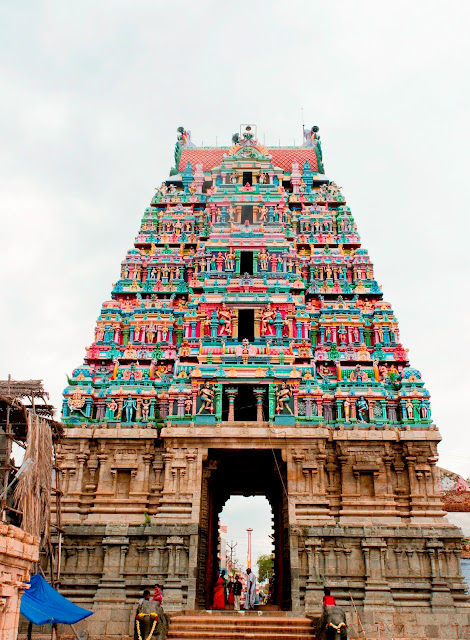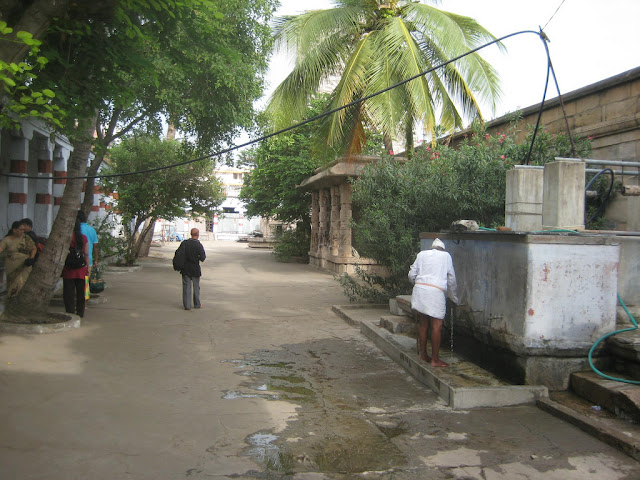Kailasanathar Temple, Tharamangalam – Temple
Architecture
This Temple
is dedicated to Lord Shiva, which is an architectural marvel with sculptures
equivalent to Madurai Meenakshi Amman Temple. It attracts visitors from various
parts of our country. Iraivan is Sri Kailasanathar & Iraivi is Sri
Sivakami Amman. Kailasanathar Temple, which is right opposite the bus station,
has a massive stone wall around it measuring 306' by 164' that was built in the
thirteenth century.
The main
5-storey, 90 ft. high entrance tower is designed as a chariot on wheels, drawn
by elephants and horses. The huge entrance doors of this west-facing temple are
made of Vengai wood (pterocarpus marsupium). They are studded with non-rusting
iron knobs, each in a different pattern. It is believed that when the enemies’
elephants come for charge they get hit by the iron knob and repel the
attackers.
The door
panels are decorated with wooden carvings of the incarnations of Vishnu,
unusual for a Shiva temple. Intermittently, the wall is embossed with stone
carvings of fish, tortoise etc., and an impressive 5-tiered gopuram (tower) welcomes
devotees. The inner courtyard is spacious and is surrounded by a pillared
corridor.
 |

The
traditional Nandi shrine, the vehicle of Lord Shiva, stands guard before the
main temple. The temple is facing west with a 5 tier Rajagopuram. When we climb
down steps through Rajagopuram Dwajasthambam, Balipeedam and Nandhi are at the
entrance of sanctum Sanctorum.
In the
outer prakaram Sannadhi for Sahasra Lingam, with Muruga Peruman,
Brahmatheertha Vinayagar, 9 Pillar mandapa Vinayagar, Sri Avinasiappar with his
consort Karunambikai. Mummudi Vinayagar is at the left side of entrance
mandapam.
In the
inner prakaram, Sannadhi for Pathala Lingam (below the ground with an entrance
of 3X3 feet opening on the floor), Sivagamiamman, Navagrahas, Murugan
Palliarai, Natarajar Saba, Oorthava Thandava Murthy, Akora Veerabhathirar,
Jurakeswarar, Kala Bairavar, Siva Suryan, Saneeswarar, Sandikeswarar, Kanni
Vinayagar, Aadhi lingam, Uma Devi, Naalvar, Vinayaga Peruman, Somaskanda
Murthy, Sri Valli Devasena Arumugar are located.
Dwarapalakars
are at the entrance of sanctum. In koshtam, Durgai, Brahma, Lingothbhavar,
Dhakshinamurthy and Nardana Vinayagar are located. The entrance to the inner
sanctum is through a portico supported by six sumptuously carved stone pillars.
The scenes of tiger hunting by princes seated on horses and accompanied by
footmen are depicted very realistically and with great sensitivity. At present the
pillar are covered using a metal frame for security purpose.
A pillar
of Yazhi (a mythical animal combining features of the lion and the elephant) is
so ingeniously carved that a stone ball (4 ' diameter) in its mouth can be
freely rolled but cannot be rolled out. The wooden doors of the portico are
adorned with twenty four panels of excellent carving, some of which have been
vandalized. The motifs for these carvings are drawn from the divine exploits of
Siva and scenes from the daily lives of ordinary people.
The
great hall is a fine gallery of sculptures of men, women, and Gods among which
the sculpture of the voluptuous rishi Pathini (sage’s wife) is notable. The
different expressions of rishi Pathini are shown very beautifully. In this The
Rishi Pathini is confused whether to protect her fruit from the parrot which is
about to pick it up or to dress her bottom which is in the state to fall down.
Each and every detail of her accessory is also shown by the delicate carving.
In the next sculpture sadness and aggression would have been shown in Rishi
Pathini’s face as the parrot has taken away the fruit which she was having in
her hand.
Another
remarkable sculpture is the dance of 18 armed Lord Shiva (Nataraja). The scene
of Lord Shiva picking up his fallen earring from the ground with his foot and
placing it back to his ears is beautifully carved out. The human anatomy has
been studied and understood so well during those periods. The minute detailing
of the nerves projecting out in that position has been clearly observed the
sculpture has been carved out so amazingly.
In the
next sculpture the expressions of Lord
Shiva and Parvathi where Lord Parvathi is angry over Lord Shiva
and he is trying to console her. This scene is beautifully shown by the way
they have carved the position of Lord Shiva’s hand near Parvathi’s chin with a
pleasing expression. And Lord Parvathi’s hand kept down with an adamant and a
non-convincing expression. It is so surprising that the detailing of the fishes
and under water reptiles have also been carved out in the Ganges which runs
over Lord Shiva.
Sculptures
on the pillars worth to see are, Rishi Pathini, Parvathy, Bikshadanar, Rishi
Pathini, Mahavishnu in Mohini Avatharam, Patanjali, Viyakrapathar, Jeyamuni,
Hayakkreevar, Oorthuva Thandavar, Shiva & Sakthi in anger mood, Shiva and
Sakthi in peaceful mood, Maha Vishnu, Akora Veerabhathirar, Agni
veerapathirarar, Pradosha Nayagar, Dhakshinamurthy, Dwarabalagar,
Sri kali, Ayannar, Manickavasakar, Brahma, Kanchi Kamakshi, Manmadan, Rathi, Thiruganasambhandar,
Thirunavukarasar and Munivar perunthakai.
The
Kailasanathar Temple has a unique carving of Manmathan, (Cupid) looking at
Shiva and Parvathi. If you look from the side of Manmathan, both Shiva and
Parvathi are visible. However, if you look from Parvathi's side, Manmathan is
not visible since he is supposed to be hiding from Shiva's view.
Kailasanathar
Temple’s main shrine has two subsidiary shrines in front of it that forms a
central passage leading to the main shrine. A fascinating ceiling covers the
space between these three shrines. The ceiling is supported by rows of stone
pillars, and elegant chains carved out of solid stone hang from the capitals.
The ceiling itself is covered by a stone wheel seven feet in diameter carved in
the shape of an inverted open lotus with parrots and surrounded by the Gatti Mudali
insignia.
A stone
wheel ringed with pecking stone parrots is the highlight. It is claimed that
the wheel can be freely rotated. The ceiling is supported by rows of stone
pillars from whose capitals hang elegant chains carved out of solid stone. It
is said that the chains were connected to the lotus in the middle from all the
four side. But now due to various reasons the chain has been broken and only
its remains which are found hanging from the ceiling. The outer walls of the
innermost sanctum are covered with inscriptions. The wheel, they say, can be
freely rotated. The scenes of princes seated on horses and hunting tigers with
footmen accompanying them are realistically sculpted.
Also
depicted at the temple is a scene from the Hindu epic Ramayana that is Vali
& Sukrivan fighting, depicted on one pillar, and Lord Ram with bow and
arrow aiming to kill Vali depicted on another pillar. If we look from vali’s
side Lord Ram is not visible. Where in if we look from Lord Ram’s side Vali can
be seen.
The main
shrine stands at a level slightly below the level of the pradakshina path
(circumambulatory path). This path is full of detailed sculptures of gods,
goddesses and saints. There is an 18-armed sculpture of Lord Nataraja, the
dancing form of Shiva. The 63 Nayanmars and 4 Nalvar saints, the teachers and
poets of Shaivism, are also represented. These sculptures are in active use,
glistening with oil, decorated with vermilion, and lamps burn in front of them
lit by devotees.
It has a
special Vinayagar statue on which if you pour water it will go to a well below
it and you can't see through which the water travels through and you can hear
the falling sound of the water. And the temple has a secret underground way
which the king who builds the temple uses to travel to another temple called Sokkanathar
temple located at Amarakundhi located 6 km from Tharamangalam.
The
outer walls of the inner most sanctums are covered with inscriptions. Several
gigantic monolithic pillars of pink granite carved, polished, and ready for
erection in the proposed Thousand Pillar Hall lie outside the temple. More are
said to be under the ground. Before this project could be completed, Vanagamudi
Gatti Mudaliyar was killed in 1667, leaving the foreground of the temple littered
with ruins of a noble dream.
There is
one notable thing in this temple which most of the tourist wouldn’t have noticed.
For some reason while constructing this temple they have made carvings of
motifs all over the temple with minute holes in it which people hardly notice.
Few believe that the holes have been kept for the insects and ants to play
around or to build their web in it. But the real actual reason is still not
known.
There is
an underground chamber and ante-chamber which can be accessed by a few steps.
These chambers are only 6 feet high. There is a small stone linga, not
bigger than one’s thumb. It is a linga because it stands on a
substantial peeta.
Such
amazingly carved out sculptures during the 17th century make today’s
architects and engineers wonder. It is unfortunate that a temple having such
great artistic beauty is hardly known or been recognised to the world. And it
is also sad that few sculptures are covered with metallic frames due to security
purpose and its minute carving and its beauty is not been able to see
properly.






























































































